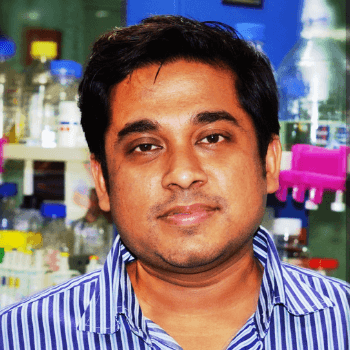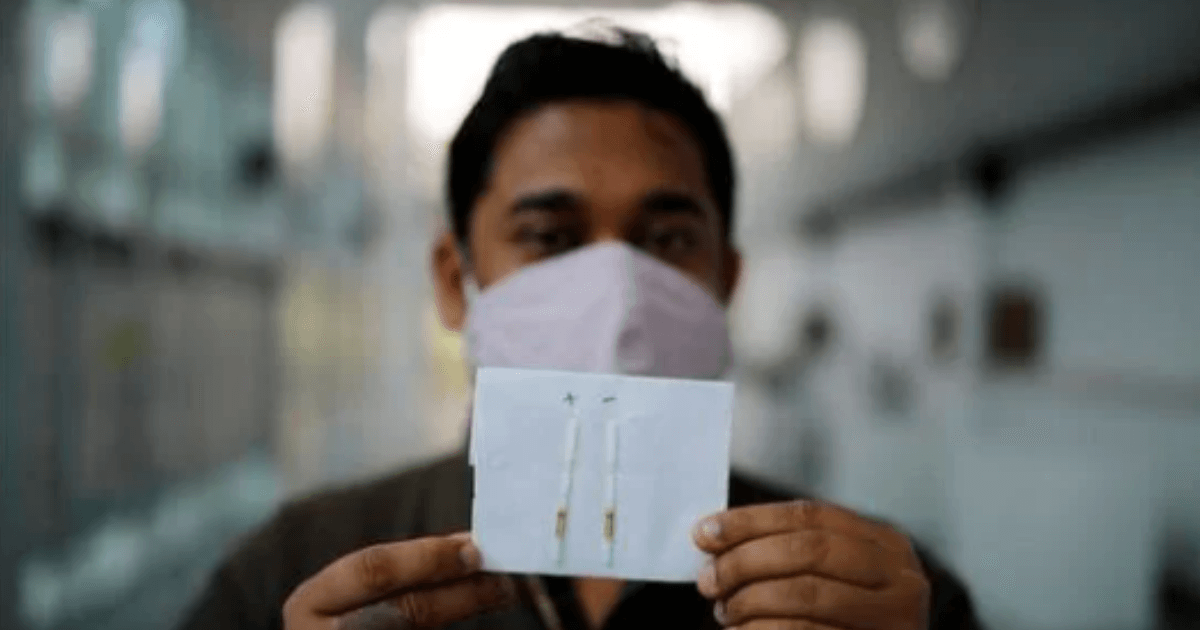
Dr. Debjyoti Chakraborty is presently a Senior Scientist at CSIR-IGIB, Delhi. His lab is engaged in developing genome editing tools for contributing to sustainable healthcare solutions including therapeutics and diagnostics. Apart from this the lab also focuses on understanding neurodevelopmental diseases using brain organoids.
Dr. Debleena Bhattacharya interviews him regarding his views on his recent achievements on developing a cheaper, faster and simpler alternative to RT-PCR, the gold standard in the diagnosis of COVID-19 known as FnCas9 Editor Linked Uniform Detection Assay (FELUDA), a paper-based strip test for coronavirus
1. Three important events happened in 2020 linked with life sciences and the topic that you work upon. COVID-19, Noble prize for the work of CRISPR and AlphaFold winning the CASP 14 challenge. What is your reaction to them? What is the impact of these events in the next 3-5 years on life science research?
The impact of each of these three things will be unprecedented in coming years. CRISPR Nobel Prize was only a matter of time, however the award going to two terrific women scientists in a year when women have excelled in almost every field from politics to science is hopefully going to improve gender inequalities and inspire young female scientists to take up a career in scientific research. AlphaFold’s development can potentially revolutionise custom protein design and is only the beginning of our understanding of what AI can do and achieve. Finally, the pandemic, with all the negativity that it has created across every spectrum, has truly brought science to the doorsteps. The collective action of the medical and scientific fraternity to fight against this pandemic through innovations and discoveries will hopefully prepare us for more challenges to come. Importantly, it reemphasizes the importance of funding good science consistently.
2. FnCas9 Editor Linked Uniform Detection Assay (FELUDA) that employs a direct Cas9 based enzymatic readout for detecting nucleotide sequences and identifying nucleobase identity without the requirement of trans-cleavage activity of reporter molecules. How is this study different from Cas12 based lateral flow assay detection used by WHO and US CDC assay?
The difference is in the mechanism of detection that the individual Cas proteins employ. Cas12/13 causes collateral cleavage of reporters while FELUDA uses direct binding-based readouts. The USP of the former is the sensitivity to ultra-low copy numbers while the USP of FnCas9 is its high specificity to mismatches and remarkable accuracy. This is to put to test with RAY (Rapid variant AssaY) that can diagnose CoV2 variants that are different by a single mismatch (https://www.thelancet.com/journals/lancet/article/PIIS0140-6736(21)00470-0/fulltext#articleInformation).
3. You are also focused on CRISPR related work with sickle cell anaemia, which is an important topic for India. When do you expect the implementation of the successful treatment using CRISPR based methods in India? Also, will these be affordable solutions for the larger population?
That is my primary work and we are extremely passionate about bringing it to people at some stage. We are at a point where we have finished with lab studies and are soon going to investigate if our approach is feasible on non human models. We have extensively worked on engineering the FnCas9 to make it more suitable for therapeutic editing. Actual implementation would require thorough trials and most importantly the support of the policy makers. Doing genome editing in human cells for therapy will require understanding and discussions across various strata of stakeholders and the common public.
4. We have seen numerous collaborations around COVID-19 where researchers are developing diagnostic tests for vaccines. Being a researcher yourself, what was your journey like for the past one year? If you can also share your pivot from working on sickle cell anaemia to developing Feluda and then Ray?
The pandemic showed the power of collective work. In addition to our industrial partners (Tata Medical and Diagnostics) we have continuously benefitted from discussions and support from scientific colleagues across institutes, startups, policy makers, clinicians and common people. As a researcher most of our time is spent in the lab in normal times; this, this experience over the last year has been remarkable. Not only did we learn how to implement experimental workplans but also to discuss and understand the views of different types of partners in this process. When we were working on the SCA, we devoted our skills purely from the scientific viewpoint. We realised its application in CoV2 diagnosis very early (Jan 2020) and thanks to the unrelenting efforts of a talented bunch of students, were able to implement the FELUDA prototype at break-neck pace. Under normal conditions, innovations from lab to market are long and arduous routes. The pandemic taught us that this doesn’t necessarily have to be so. While working on FELUDA and the tech transfer to the product TATA MD CHECK, both I and Dr. Souvik Maiti had multiple roles to play, several of which we learned on the job. The support and constructive enthusiasm of Dr. Anurag Agrawal, Director IGIB has been phenomenal during this whole process.
5. Many industries have suffered due to COVID-19 impact, especially travel and tourism. WHO and others are talking about a vaccine certificate based passport which allows people to move. Do you think CRISPR based tests can get wider acceptance cross border such as RT PCR. What can be done to ease out pressure on these distressed sectors? Why are CRISPR based tests not mainstream globally despite being developed already last year in some parts of the world?
I totally agree and if the current work reaches some sort of conclusion we hope to have CRISPR tests done more frequently (particularly for the RAY based variant detection). One has to remember that technologies become better as more and more people use them and improve them. qRT PCR was popularized in 1994 and it took so many years to get it ready for mainstream diagnosis. CRISPRDx is only about 2-3 years old (and even younger in India) and it is going to get better, faster and cheaper as more people use it and make it more robust. It is important for regulatory authorities to have faith in new and promising science and promote it as an investment that will pay rich dividends in the future.
6. What inspires you to do research in life sciences (around CRISPR)? Any Indian / global scientist/personality that inspires you on a daily basis? If you could also recommend a book to younger readers that may inspire them to take up science?
My approach towards science has been one of problem-solving. The excitement of solving a biological question is what inspires me. Once I started working on genome editing I have been getting mails from parents of kids who have a lot of hope in this technique and feel one day it can save their children from some of the incurable diseases that they are suffering from. This is my greatest inspiration and something that I am happy to focus on priority over other scientific pursuits.
A lot of scientists inspire me. Feng Zhang, George Church, David Liu, Jennifer Doudna, Marina Cavazzana are few of the contemporary names in my field. I am intrigued by George Church’s approach to science as an innovator and the fresh ideas he comes up with. Among contemporary Indians, Gagandeep Kang, Shahid Jameel and our very own Anurag Agrawal are some of the personalities I admire for their depth of knowledge and outlook towards scientific and clinical problems. My choices for books would be The double Helix, Sapiens and the newly released The Code Breaker.
7. In the CRISPR journey we have seen some fundamental basic curiosity driven research leading towards important applications. What is your message to students and young researchers who aspire to take the same path? What should we focus on in India in the next 3-5 years for example, to get good results from the incorporation of CRISPR / AI in life sciences?
It is important to remember that at the end of the day, CRISPR is a technology and like any other technology it will evolve, get better, have more applications and be eventually replaced. Thus it should not be seen as the one-stop solution to your problem. Every problem requires critical thinking and innovative approaches, a one-size-fits-all need not be the best or the most apt way to solve a range of biological questions. The best minds will find ways to learn from nature (like scientists learned in the case of CRISPR) and come up with improved solutions.
8. We have seen many scientists embrace the arts route in infusing the new ideas in their scientific journey. Being associated with music,in your opinion how does hobbies play an important part in teaching us life lessons?
Arts and humanities teaches us to appreciate and enjoy life in a non-objective manner. I would insist that pursuing an alternate interest (outside science) should be done seriously and not just as a hobby. This is because it pays rich dividends even in one’s scientific career. Practice associated with perfecting an art improves the analytical skills of a scientist and helps make friends and contacts in unexpected locations. It is a release point for stress and anxiety.

